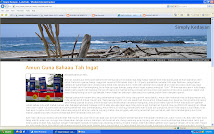The Transformation of Superstitions into TraditionThe Kadayan kids of my time were living in a unique environment where modernisation was not expected to arrive in the next twenty years or so then. We were surrounded by
nature; our livelihoods, to certain extent were highly influenced by the environment we lived in. As mentioned several times in the previous articles the Kadayan people close
relationship with nature from that of the
forest, jungle, rivers, wild animals, birds, fishes and jungle produces (fruits, roots and shoots) were part of our upbringings.Our elders taught us the skills on how to find food from mainly two sources; first from nature itself and secondly from traditional farming methodologies i.e. hill paddy, fruit trees, vegetables and roots. Food sources acquired from nature were considered as
gift from Allah SWT to the Kadayan people. Such food sources were abundant and
“free” and the only costs tied to them were our time and energy finding them.
The
Olden Days Kadayan people were naturally superstitious, a common characteristic of the world’s tribal communities and great ancient civilisations. Superstitions amongst the Kadayan community are mostly linked to the belief that some form of rituals, choosing the right day, date, & time had to be performed or determined before performing or embarking on certain tasks to ensure
safe, swift and successful implementation of the tasks. As time passed by, what used to be
strong superstitions amongst the Kadayan people were transformed into merely a tradition without any significant influence to their faith as the professors of Islam religion. I have written some interesting articles related to the
Olden Days Kadayan which may be of interest to the readers in my other blog entitled
Reaping the Benefits. Please click
here to find out more.
 Long beans
Long beansWhen I was a small kid my late mother used to tell me not to plant leafy vegetables such as
long beans, cucumbers, pumpkins, etc. on Saturday, the leaves would be swarmed and eaten by pests such as caterpillars (larva of a butterfly or moth) and grasshoppers. The other interesting situation as told by my late mother was to lick my palm and put it at the forehead by saying
“Sia sia pun kaladina” when I have to leave the house before consuming any food that I was asked to do so. My late mother also used to ask me to touch the food such as rice, boiled tapioca, etc. before going out. Such action would ensure my safety while playing or performing any tasks outside the house. Our forefathers used to believe that by doing so it would neutralised the effect of
“kapuhonan” believed to be the “invincible power” that caused accidents and injuries.
Other interesting examples with regard to the Kadayan people’s superstitions are as follows: -
1. Not to go out during
“hujan panas” (raining with sunshine). Our forefathers used to believe that during
“hujan panas” super natural beings would come out for a walk and to avoid stumbling with them, the kids were refrained from going out at the time. Breaching the code of conduct would cause the kids to suffer
“kataguan”. “Kataguan” is a syndrome believes to be caused by invisible supernatural beings in contact with the humans. The common effects of
“kataguan” are
continuous crying, nightmares, high fever, and a more serious effect would be memory lapsed. If such symptoms persisted, our parents would call a spiritually competent person of the village to treat the effect of
“kataguan”;2. Not to
play or perform any tasks at dusk. Our forefathers used to believe that such time is an accident prone time of the day and also the time when supernatural beings are roaming about to do their chores. My late mother used to give me the following advices (in Kadayan dialect): -
 sunseta. Jangan bamain aie malamaie (Don’t play at dusk)
sunseta. Jangan bamain aie malamaie (Don’t play at dusk)
b. Jangan tidoo aie malamaie (Don't sleep at dusk)
c. Jangan bakaaja aie malamaie (Don’t work at dusk)
d. Jangan basiul aie malamaie (Don’t whistle at dusk)
e. Jangan bagalap aie malamaie (Don’t crack jokes at dusk)There were a lot of known Kadayan superstitions / traditions where some form of initiation rituals had to be performed prior to embarking or performing certain tasks the Kadayan people normally do. Depicted below are some of the situations: -
1. Opening of new settlement area or land for farming (Nataki). Click
here to know more about Nataki.
2. Building New Houses (“Mahunjam”)
3. Planting paddy (especially “nugal & ngatam”}
4. Planting of cash crops
5. Marriages
6. Going hunting, fishing (Manuba).
7. Individual leaving the village for a long duration of time
8. Circumcision
9. etc.
Our forefathers used to believe that forest and jungle were the home of supernatural beings such as
jin, iblis and shaitan. It was only appropriate before ones embark on a journey into the forest or jungle; some rituals had to be performed to ensure that the supernatural beings would recognise that the humans visiting their territories came in good faith not to make wars or create troubles.
 kayu ara
kayu araThe
jin, iblis and shaitan, being supernatural beings would caused troubles to the humans regardless of the situations. It is their nature to trouble human beings anywhere. The kids of my time were
well-informed of the
dos and don’ts while in the forest or jungle. We were told to avoid places where supernatural beings love to stay such as in a
gloomy places, large trees with buttress roots, a large parasite tree called “kayu aa” with hanging roots, large boulders, caves, etc. These are the places where supernatural beings are likely to be found and to avoid those places at all costs. Being small kids we complied 100% with our parents’ advice and never come close to those places. Another good advice from our elders pertaining to our forest or jungle adventures are as follows: -
a. Never mention to each other if we see extra ordinary “things” while in the forest or jungle;
b. Do not crack any jokes, talk loudly or whistling (basiul);
c. Never harm insects and small animals;
d. Never throw any food remnants (rice, fish bones, etc.) all over the places;
e. If we need to consume fish we caught while in the jungle in a simple barbeque style, the
“stomach / belly” part had to be taken out. We were told that the supernatural beings would recognise the smell from the smoke whether the fish belly is taken out or other wise. The supernatural beings would be very angry if fishes were barbequed with its
belly in and thus creating
whirlpool of wind (twister) that disturbed the serenity and tranquillity of the jungle. If such situation persisted, we have only two options, firstly try to
“persuade” the beings to stop the twister or secondly run away as fast as we could from the “disaster zone”.
I would take the second option!To be continued…




























